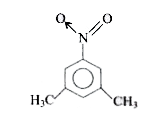How many of the following groups are ortho,para directing and ring activating?
−NO2,−CN,−CH3,−OH,−NH2,
−OR,−X,−CHO,−NHR
The correct Answer is:5
To determine how many of the given groups are ortho, para directing and ring activating, we need to analyze each group based on its electronic effects on the benzene ring.
1. -NO₂ (Nitro group): This group is a strong electron-withdrawing group due to its -I (inductive) effect and -M (mesomeric) effect. It deactivates the ring and directs substitution to the meta position.
- Conclusion: Not ortho/para directing, not activating.
2. -CN (Cyano group): Similar to the nitro group, the cyano group is also an electron-withdrawing group. It deactivates the ring and directs substitution to the meta position.
- Conclusion: Not ortho/para directing, not activating.
3. -CH₃ (Methyl group): This group is an electron-donating group due to its +I effect. It activates the ring and directs substitution to the ortho and para positions.
- Conclusion: Ortho/para directing, activating.
4. -OH (Hydroxyl group): The hydroxyl group is an electron-donating group due to its +M effect (resonance). It activates the ring and directs substitution to the ortho and para positions.
- Conclusion: Ortho/para directing, activating.
5. -NH₂ (Amino group): The amino group is also an electron-donating group due to its +M effect. It activates the ring and directs substitution to the ortho and para positions.
- Conclusion: Ortho/para directing, activating.
6. -OR (Alkoxy group): Alkoxy groups (like -OCH₃) are electron-donating due to their +M effect. They activate the ring and direct substitution to the ortho and para positions.
- Conclusion: Ortho/para directing, activating.
7. -X (Halogens): Halogens (like -Cl, -Br, -I) are unique; they are weakly electron-withdrawing due to their -I effect but still donate electrons through resonance (+M effect). They direct substitution to the ortho and para positions but are considered deactivating overall.
- Conclusion: Ortho/para directing, but weakly activating.
8. -CHO (Aldehyde group): The aldehyde group is an electron-withdrawing group due to its -I effect and does not donate electrons through resonance. It directs substitution to the meta position.
- Conclusion: Not ortho/para directing, not activating.
9. -NHR (Amino group with a hydrogen atom): Similar to the amino group, this is also an electron-donating group due to its +M effect. It activates the ring and directs substitution to the ortho and para positions.
- Conclusion: Ortho/para directing, activating.
Now, summarizing the findings:
- Ortho/para directing and activating groups: -CH₃, -OH, -NH₂, -OR, -X, -NHR (6 groups)
- Not ortho/para directing and not activating: -NO₂, -CN, -CHO (3 groups)
Final Answer: There are 6 groups that are ortho, para directing and ring activating.
- Conclusion: Not ortho/para directing, not activating.
- Conclusion: Not ortho/para directing, not activating.
- Conclusion: Ortho/para directing, activating.
- Conclusion: Ortho/para directing, activating.
- Conclusion: Ortho/para directing, activating.
- Conclusion: Ortho/para directing, activating.
- Conclusion: Ortho/para directing, but weakly activating.
- Conclusion: Not ortho/para directing, not activating.
- Conclusion: Ortho/para directing, activating.
- Not ortho/para directing and not activating: -NO₂, -CN, -CHO (3 groups)
Similar Questions
Knowledge Check
In which of the following molecules −NO2 group is not coplanar with phenyl ring?
A B
B C
C D
D
Why is −CH3 group ortho and para directing in toluene ?
View SolutionSelect the principal functional group when the following groups are present in the molecule :
(a) −OH,−COOH,−NO2
(b) −OCH3,OH,−Cl
(c) −CHO,−CN,−OH
(d) −Cl,−CONH2,−CHO
View SolutionRank the following groups in order of decreasing priority for R, S configuration.
−NH2,−CH2NH2,−CH3,−CH2NHCH3
View SolutionRank the following groups in order of decreasing priority for R, S configuration.
−COOH,−CH2OH,−H,−CHO
View SolutionSort out the o- and p- and m-directing groups among the following:
−CN,OH,−CH3,−SO3H,−CHO
View SolutionWhat is meant by directive influence of groups ? Sort out the o- and p-, and m-directing groups among the following ?
−OH−CN,−COOH,−CH3,−Br,−OCH3,−SO3H
View SolutionRearrange the following compounds in the increasing order of their boiling points :
CH3−CHO,CH3−CH2−OH,CH3−CH2−CH3
View Solution
